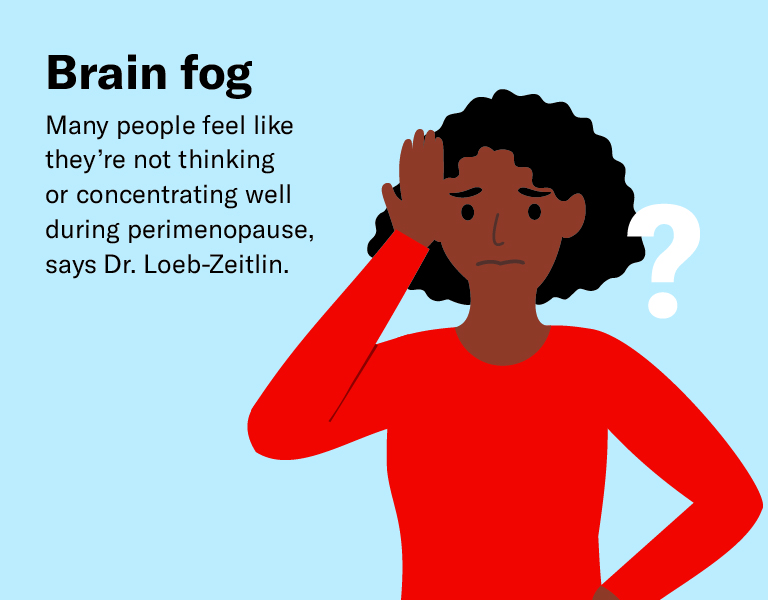Perimenopause and Menopause: 6 Things to Know
What to expect, and how to manage challenging symptoms like hot flashes and mood swings.

Declining estrogen levels in the time leading up to menopause, known as perimenopause, can cause symptoms like unpredictable periods, mood swings, and sudden hot flashes. But there’s a growing array of treatments to tame bothersome symptoms and ease that transition, says Dr. Susan E. Loeb-Zeitlin, an obstetrician and gynecologist at NewYork-Presbyterian/Weill Cornell Medical Center and director of the Women’s Midlife Center at Weill Cornell Medicine.
While some people go through perimenopause with few problems, “there are many things that we can do if you’re not feeling well during this transition in life,” says Dr. Loeb-Zeitlin.

Dr. Susan Loeb-Zeitlin
Dr. Loeb-Zeitlin emphasizes that people experience perimenopause in different ways, and that there isn’t a one-size-fits-all approach to symptom relief. One patient might benefit from hormone treatment, while another does fine with daily yoga and prioritizing sleep. “The care that we give is individualized,” she says. “Each person and their physician can come up with a regimen that works for them.”
Here, Dr. Loeb-Zeitlin shares important facts that can help you face this phase of life.
1. Menopause has three phases.
Perimenopause is the roughly two- to seven-year period marking the transition to menopause. It begins with irregular menstrual cycles, due to declining ovarian function, and ends a year after the last menstrual period. Perimenopause usually starts in your mid-40s, though the timing varies from person to person. It can cause a wide variety of symptoms, including hot flashes and night sweats, menstrual irregularities, mood changes and increased premenstrual syndrome, insomnia, vaginal dryness, and brain fog. “Symptoms typically last from two to five years,” says Dr. Loeb-Zeitlin. “By the time a woman stops getting her period, some of these symptoms may start to improve.“
Menopause occurs when you have gone 12 consecutive months without a period. At this point, you are no longer ovulating or capable of reproduction. This represents a moment in time and usually happens between ages 40 and 58; the average age is 51½. Starting to skip periods may be a sign that you are approaching menopause in a few years.
Post-menopause is the period after the transition to menopause is complete. It lasts until the end of a person’s life.
2. You can get pregnant right up to the time you reach menopause.
Unless you are trying to conceive, you need to use some form of birth control during perimenopause, says Dr. Loeb-Zeitlin.
“These ‘change-of-life babies’ definitely do happen,” she says. “We recommend the use of contraception until you are defined as being menopausal — in other words, a year has passed since your last menstrual period.”
3. Behavioral and lifestyle changes may be all you need to manage symptoms.
Reducing your caffeine and alcohol intake can help reduce mood issues and promote better sleep quality, says Dr. Loeb-Zeitlin. Regular exercise can turn down the heat of hot flashes and night sweats.
“Yoga, meditation, and deep breathing are all helpful strategies,” says Dr. Loeb-Zeitlin. “They might not get rid of symptoms like hot flashes, but they help dissipate them to a point where they might be more tolerable. I’ve had patients improve their symptoms of menopause just through yoga.”
4. Hormones can offer significant relief.
Hormone therapy is an excellent option when symptoms like hot flashes and night sweats are severe.
“The good news is there are so many different ways we can treat symptoms with hormones,” says Dr. Loeb-Zeitlin. These include estrogen pills, creams, and transdermal patches, which are taken with progesterone. “Hormones may also help with brain fog,” she adds, though they aren’t FDA-approved for that symptom.
“Vaginal creams and pills containing estrogen are FDA-approved for the treatment of vaginal atrophy and urinary symptoms like urinary urgency and frequency,” says Dr. Loeb-Zeitlin. Over-the-counter vaginal moisturizers, which don’t contain hormones, can help reduce dryness and related symptoms.
Some people have concerns about using hormones because previous studies showed higher rates of heart disease, breast cancer, blood clots, and stroke with their use, says Dr. Loeb-Zeitlin. But the treatment is very safe when it’s used by people who start by age 60 or within 10 years of the onset of menopause, she says.
When menstrual irregularities and bleeding are the primary problems, low-dose birth control pills can often help to balance out the cycle until a person reaches menopause.
5. Medications can ease the transition.
Several nonhormonal prescription medications effectively quell the symptoms of menopause and perimenopause for those who are looking for alternatives to estrogen, Dr. Loeb-Zeitlin says.
Medications known as SSRIs (Paxil, Prozac) and SNRIs (Effexor) are normally used for depression and anxiety. “But at very low doses they treat hot flashes and sleep problems, and may be particularly helpful for patients who are also experiencing anxiety, depression, PMS, and mood swings,” says Dr. Loeb-Zeitlin.
In addition, “gabapentin (Neurontin), an antiseizure and pain drug, decreases hot flashes as well and can be helpful for sleep, since it tends to have a sedative effect,” she says.
Recently, the FDA approved a nonhormonal medication, called Veozah, to treat moderate to severe hot flashes caused by menopause. This new therapy targets the neurons in the brain that cause hot flashes and offers an option for people who can’t or don’t wish to take estrogen.
6. Other health issues can crop up around menopause.
The changes of perimenopause and menopause can lead to or coincide with other health concerns you need to keep an eye on. “This is a good time to assess just where you are now with your health and lifestyle,” says Dr. Loeb-Zeitlin.
It’s common to see a rise in cholesterol levels, the loss of bone mass, and weight gain during perimenopause. “Even if we don’t see weight gain, often there’s a change in body composition, with more fat deposited in the midsection and a greater ratio of fat to lean muscle mass,” says Dr. Loeb-Zeitlin. “We can combat these with diet and exercise, specifically resistance training.”
After the turmoil of perimenopause and menopause recede, symptoms may disappear, bringing about a sense of relief and new opportunities for fulfillment, says Dr. Loeb-Zeitlin. “Some people enjoy the fact that they no longer menstruate and that they don’t have to worry about pregnancy,” she says. “It’s also a time for women to address their own personal health.”
Susan E. Loeb-Zeitlin, M.D., FACOG, is an obstetrician and gynecologist at NewYork-Presbyterian/Weill Cornell Medical Center. She is director of the Women’s Midlife Center and an assistant professor of clinical obstetrics and gynecology at Weill Cornell Medicine. She treats women of all ages, from adolescence through menopause. Her goal is to provide complete, personalized women’s healthcare that encompasses all the special health issues women face, including family planning, balancing work and personal life, and the challenges of aging. She is a North American Menopause Society Certified Menopause Practitioner (NCMP).






